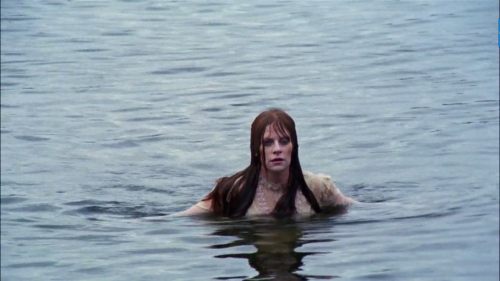Rocking Out At The PROJECT ALMANAC Set
I’ve never been to Lollapalooza, but visiting the set of Project Almanac in June 2013, I felt like I had. Walking through an enormous, muddy field, we passed hundreds of extras dressed in fur hats, suspenders, short shorts, culturally appropriating headdresses and tiny beaded crop tops, all the crazy vestments you’d expect to see on teenagers at a large outdoor music fest. There was a huge inflatable water slide (in operation!), a funky umbrella fountain and a couple of big stages and tents. The scene was so convincing that one of my colleagues tried to use a Porta-Potty that turned out to be solely for decoration. He was promptly directed to the set’s working restroom.
And running through all of it was an enormous “Before The World Ends” wall scribbled in neon with lifelong ambitions by festival-goers (or, okay, set designers). “Eat one perfect meal.” “Dance naked in the rain.” “Think of something better to write on this wall.” Maher Ahmad, the production designer, admitted, “Some of the guys were getting funny like, ‘I’d like to slap Bobby.’ He’s the foreman.”
The world-ending wall is a big scene in the movie, as our lead David Raskin (Jonny Weston) attempts a first kiss with the love of his young life, Sofia Black-D’Elia’s Jessie. First time feature director Dean Israelite says,
This scene is pivotal. To me what’s awesome about this movie is that it has all of these big ideas, has a cool approach to it in the fact that it’s found footage and treating this high concept in that way, but it also has real heart between all of these characters and I think it’s a coming of age story and a love story that’s all brought really wonderfully into the material. And this is a pivotal scene in that our main character has built this time machine with all of his friends, have gone on this journey of awesome stuff, winning the lottery, paying off their houses, just doing great cool shit and they miss this huge music festival. They didn’t have the money for it and now they get the opportunity to ditch class. They are all meant to be in chemistry right now. They ditch class and come to this huge music festival and this is the scene where the protagonist is about to make his move on the girl and he tries to and she opens the door for him and at the very last minute he is too scared to take the bull by the horns and lean into her, because that’s been his problem the whole movie. So this is a scene where you feel that these two are finally going to come together and he blows it. It sets up the second half of the movie about what he will have to do and places he will have to go and the rabbit hole he will have to go down in order to get the girl, all the moral compromises he will make to try and get that.
And therein lies the concept of Project Almanac, a found footage movie that questions what teenagers would do with the power of time travel. They go to Lollapalooza. They kiss the girl. They ditch chemistry class. As writer Andrew Stark says, the movie’s intention is to “You know, watch kids try to get back further, and further, and further, and do more damage in their life. And treat time travel as more of a superpower than actually, you know, just a place to go to like other movies have.”
The film is found footage for a couple of reasons. In story, David and his friends are searching through his attic when they find his late scientist father’s old blueprints for a time travel machine, as well as his dad’s old video camera. They decide to build the time machine and document the process with the video camera and with their phones. Why do they choose to film this adventure? Producer Brad Fuller has an answer for that. “All I can tell you is my kids shoot everything that happens. I have a 19-year-old and a 16-year-old - you’re welcome to talk to them – and there is nothing in my house that is private anymore. So this is what these kids do. I mean, my dinner last night is on the Internet.”
If the camera and superpower aspect of the story sounds a little bit like Chronicle, well, that’s not an accident. Fuller adds:
For us, a movie that we really loved at our company and we didn’t have the opportunity to make was Chronicle. We thought that movie was terrific. And when we read that script we really wanted to make that movie and we didn’t get it, but we were always yearning to do a movie like that. And this felt a little bit Chronicle-y to us, although it has probably a happier ending than that one did. But you know, that was kind of the model for us.
And Chronicle isn’t the only movie that inspired Project Almanac. The title specifically refers to the name of the DARPA (Defense Advanced Research Projects Agency) time travel project David’s father was working on in 2004, but when asked if “Almanac” is also a reference to Marty’s sports almanac in Back to the Future Part II, Stark said,
Yes. The movie is fraught with sort of Easter eggs and secrets, and little moments and things that harken back to many different parts of mythology. One of which being that, in our head at least, the original people who started designing the blueprints were fans of time travel movies and certainly some wise-ass in this sort of DARPA covert operation decided to name it after something he was a fan of… That was in our heads, at least. I hope I don't get sued for that.
But the filmmakers worked to set Project Almanac apart from its predecessors, particularly in the look and feel of the time travel. Israelite said:
I think the concept behind it is it really affects the environment in adverse ways, so when you turn the time machine on there’s going to be a whole bunch of chaos. There’s going to be weightlessness involved, because it has this electromagnetic energy - all of the metal objects around you start to levitate, a bunch of stuff just starts to shake. There’s shockwaves that emanate out from the time machine and so when you’re outside it’s almost like this huge storm starts to brew. Things speed ramp, but again all of the chaos is grounded in real elements in a scene. So when they are down in the basement and they turn the time machine on, all of the tools start to levitate and spin and the glass starts to shatter and freeze and maybe go backwards and reform itself. The camera starts to levitate, because it’s metal, so it starts to take on a life of its own and the characters have to yank it out of mid-air. Their hair starts to stand up on end, because it’s all this static electricity. We just shot a scene where they unscrew a light bulb, but the light bulb stays on, because it’s giving out all of this electromagnetic energy, and then outside when they time jump outside, there’s going to be shockwaves that hopefully will feel like a bomb blast went off in the middle of the group kicking up all of this dust and debris toward the lens. So the time machine is very chaotic and everything that the time machine affects is grounded in the real world with things that we’ve seen. I’m sure we’ll have some kind of light gag going on, but I’m hoping that there isn’t anything out of the real world playing in that scene, so no sort of weird blue thing or portal that you walk through. It’s the regular world reacting in irregular ways.
And in keeping with that grounded, real-world aesthetic, Israelite said the time machine will be “very glued together, sort of MacGyvered together, and they create it from parts from Home Depot and stuff they found in their basement. What’s cool about it is they can’t afford… they find all of these blueprints, these schematics from twelve years ago that were put together by DARPA, but they don’t have the money or the resources to build the machine that’s laid out, so they have to provide their own ghetto version of the time machine.” And this aesthetic has a narrative purpose as well, because the “ghetto version” of the time machine “has limited power and will only take them back a few days and a few weeks, which I also think is cool about the movie. It’s time travel, but you can only go back two days.”
But this messy, MacGyvered aesthetic will not extend to the actual cinematography of the film, which is being produced by Michael Bay. When Fuller was asked if any of the film was being shot on a real iPhone, he laughed. “No, we’re shooting it on a RED. I mean, Michael Bay’s name is on this movie. It’s gotta look a certain way. If it doesn’t, that will not be good for me.”
That’s been cool for the kids, who have been able to hold the RED for some of the found footage scenes. Sam Lerner, who plays David’s friend Quinn, said, “There was one scene that we filmed in a car that I actually got to hold the camera, because I was in the passenger seat and otherwise I would just have to not be in the car since there's physically no space. I was able to just clock everything and it was actually really fun…I was holding the RED, and I had to get them in the backseat and then I had to pan over to David who's driving. Then he opens the hood and so I got him and I was able to turn it on myself for a second, but mostly we have an operator. That's my most proud thing outside the acting.”
And all of the actors seem very excited about Bay’s involvement. Weston said, “Michael Bay, obviously, has been putting out amazing work, so…” and Black-D’elia chimed in, laughing, “He’s been pretty good lately, I guess,” while Allen Evangelista, who plays Adam (“the angel on David’s shoulder…the Spock to Kirk”) said Bay’s involvement was the aspect of the film he was most excited about. Lots of explosions, evidently.
We didn’t get to see any explosions, and no time travel either, but I have to say – that Lollapalooza set was pretty sweet.
Project Almanac hits theaters January 30. Check out the trailer below.



